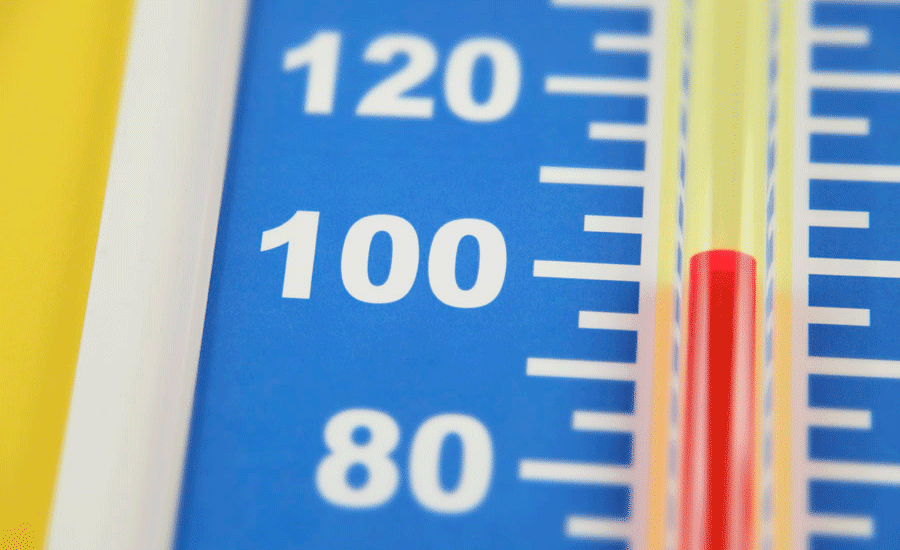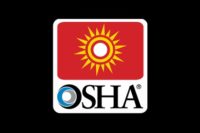Exposure to extreme temperatures can result in occupational illnesses and injuries. Heat stress can result in heat stroke, heat exhaustion, heat cramps, or heat rashes. Heat can also increase the risk of injuries in workers due to sweaty palms, fogged-up safety glasses, and dizziness. Burns may also occur as a result of accidental contact with hot surfaces or steam.
Who is at risk? Outdoor workers and workers in hot environments such as firefighters, bakery workers, farmers, construction workers, miners, boiler room workers, factory workers, and others can face exposures. At greater risk are those 65 years of age or older, workers who are overweight, have heart disease or high blood pressure, or take medications that may be affected by extreme heat.
You should reduce workplace heat stress through engineering and work practice controls. Engineering controls include those that:
- Increase air velocity.
- Use reflective or heat-absorbing shielding or barriers.
- Reduce steam leaks, wet floors, or humidity.
Work practice recommendations include:
- Limit time in the heat and/or increase recovery time spent in a cool environment.
- Reduce the metabolic demands of the job.
- Use special tools (i.e., tools intended to minimize manual strain).
- Increase the number of workers per task.
- Train supervisors and workers about heat stress.
- Implement a buddy system where workers observe each other for signs of heat intolerance.
- Require workers to conduct self-monitoring and create a work group (i.e., workers, a qualified healthcare provider, and a safety manager) to make decisions on self-monitoring options and standard operating procedures.
- Provide adequate amounts of cool, potable water near the work area and encourage workers to drink frequently.
- Implement a heat alert program whenever the weather service forecasts that a heat wave is likely to occur.
- Institute a heat acclimatization plan and increase physical fitness.
Train workers before hot outdoor work begins. Tailor training to cover site-specific conditions. Provide a heat stress training program for all workers and supervisors about:
- Recognition of the signs and symptoms of heat-related illnesses and administration of first aid.
- Causes of heat-related illnesses and the procedures that will minimize the risk, such as drinking enough water and monitoring the color and amount of urine output.
- Proper care and use of heat-protective clothing and equipment and the added heat load caused by exertion, clothing, and personal protective equipment.
- Effects of non-occupational factors (drugs, alcohol, obesity, etc.) on tolerance to occupational heat stress.
- The importance of acclimatization.
- The importance of immediately reporting to the supervisor any symptoms or signs of heat-related illness in themselves or in coworkers.
- Procedures for responding to symptoms of possible heat-related illness and for contacting emergency medical services.
In addition, supervisors should be trained on the following:
- How to implement appropriate acclimatization.
- What procedures to follow when a worker has symptoms consistent with heat-related illness, including emergency response procedures.
- How to monitor weather reports.
- How to respond to hot weather advisories.
- How to monitor and encourage adequate fluid intake and rest breaks.
Acclimatization results from beneficial physiological adaptations (such as increased sweating efficiency) that occur after gradual increased exposure to a hot environment. Ensure that workers are acclimatized before they work in a hot environment.
- Gradually increase workers’ time in hot conditions over 7 to 14 days.
For new workers: The schedule should be no more than 20% of the usual duration of work in the heat on day 1 and no more than 20% increase on each additional day.
For workers with previous experience: The schedule should be no more than 50% of the usual duration of work in the heat on day 1, 60% on day 2, 80% on day 3, and 100% on day 4.
- Closely supervise new employees for the first 14 days or until they are fully acclimatized.
- Non-physically fit workers require more time to fully acclimatize.
- Acclimatization can be maintained for a few days of non-heat exposure.
- Taking breaks in air conditioning will not affect acclimatization.
Provide means for appropriate hydration of workers:
- Water should be potable, <15°C (59°F), and made accessible near the work area.
- Estimate how much water will be needed and decide who will obtain and check on water supplies.
- Individual, not communal, drinking cups should be provided.
- Encourage workers to hydrate themselves.
Workers should drink an appropriate amount to stay hydrated.
- If in the heat <2 hours and involved in moderate work activities, drink 1 cup (8 oz.) of water every 15–20 minutes.
- During prolonged sweating lasting several hours, drink sports drinks containing balanced electrolytes.
- Avoid alcohol and drinks with high caffeine or sugar.
- Generally, fluid intake should not exceed 6 cups per hour.
Ensure and encourage your workers to take appropriate rest breaks to cool down and hydrate.
- Permit rest and water breaks when a worker feels heat discomfort.
- Modify work/rest periods to give the body a chance to get rid of excess heat.
- Assign new and unacclimatized workers lighter work and longer, more frequent rest periods.
Shorten work periods and increase rest periods as temperature, humidity, and sunshine increase; when there is no air movement; if protective clothing or equipment is worn; and for heavier work.
Source: NIOSH



